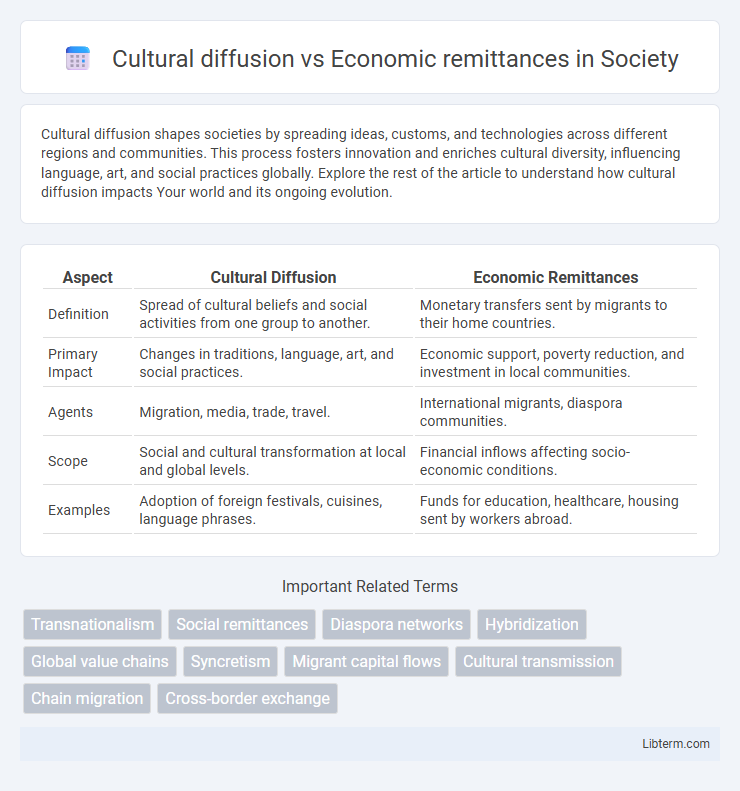Cultural diffusion shapes societies by spreading ideas, customs, and technologies across different regions and communities. This process fosters innovation and enriches cultural diversity, influencing language, art, and social practices globally. Explore the rest of the article to understand how cultural diffusion impacts Your world and its ongoing evolution.
Table of Comparison
| Aspect | Cultural Diffusion | Economic Remittances |
|---|---|---|
| Definition | Spread of cultural beliefs and social activities from one group to another. | Monetary transfers sent by migrants to their home countries. |
| Primary Impact | Changes in traditions, language, art, and social practices. | Economic support, poverty reduction, and investment in local communities. |
| Agents | Migration, media, trade, travel. | International migrants, diaspora communities. |
| Scope | Social and cultural transformation at local and global levels. | Financial inflows affecting socio-economic conditions. |
| Examples | Adoption of foreign festivals, cuisines, language phrases. | Funds for education, healthcare, housing sent by workers abroad. |
Introduction to Cultural Diffusion and Economic Remittances
Cultural diffusion refers to the spread of cultural beliefs, practices, and innovations across societies, significantly impacting language, religion, and technology. Economic remittances involve the transfer of money by migrants to their home countries, serving as key financial resources that stimulate local economies and improve living standards. Both processes shape global interconnectivity but influence societies through distinct mechanisms: one through cultural exchange and the other through economic support.
Defining Cultural Diffusion: Concepts and Examples
Cultural diffusion refers to the spread of cultural beliefs, practices, and innovations from one society or group to another, often facilitated by migration, trade, or communication. Examples include the global influence of American pop culture, the adoption of Italian cuisine worldwide, and the spread of technology like smartphones across diverse regions. This phenomenon contrasts with economic remittances, which involve the transfer of money by migrants to their home countries, primarily supporting financial stability rather than cultural exchange.
Understanding Economic Remittances: Meaning and Impact
Economic remittances refer to money sent by migrants to their home countries, significantly boosting household incomes and fueling local economies. These financial transfers support education, healthcare, and infrastructure development, creating a ripple effect that enhances community well-being and economic stability. Unlike cultural diffusion, which spreads ideas and customs, economic remittances have a direct monetary impact that drives poverty reduction and increased investment in recipient regions.
Historical Perspectives on Migration and Its Dual Impacts
Historical migration patterns reveal the dual impacts of cultural diffusion and economic remittances, where migrants transmit languages, traditions, and social norms, shaping host societies over centuries. Economic remittances, tracked extensively since the late 20th century, provide vital financial support to origin communities, enhancing development and poverty reduction. Analysis of migration flows during the Industrial Revolution and post-colonial periods highlights the intertwined roles of cultural exchange and monetary transfers in global socio-economic transformations.
Mechanisms of Cultural Exchange in a Globalized World
Cultural diffusion occurs through migration, digital communication, and international trade, facilitating the spread of ideas, customs, and technologies across borders. Economic remittances, while primarily financial, contribute indirectly by enabling migrant families to access foreign goods and media, reinforcing cultural ties and exchanges. Social networks and diaspora communities serve as key mechanisms in this globalized world, fostering both cultural diffusion and economic connections simultaneously.
Economic Remittances: Driving Forces and Patterns
Economic remittances serve as a critical financial lifeline for many developing countries, contributing significantly to household incomes and national economies. Patterns of remittance flows are shaped by migration trends, labor market demand, and migration policies, with major sending countries including the United States, Saudi Arabia, and the United Arab Emirates. These financial transfers drive economic development by funding education, healthcare, and small businesses, while also influencing global economic stability and poverty reduction efforts.
Social Transformation through Cultural Diffusion
Cultural diffusion fosters social transformation by spreading ideas, customs, and technologies across societies, leading to increased cultural diversity and innovation. This process reshapes social norms, values, and behaviors, promoting greater tolerance and understanding among different communities. Unlike economic remittances that primarily influence financial stability, cultural diffusion drives enduring social change by embedding new cultural elements into everyday life.
Economic Development Fueled by Remittances
Economic remittances significantly boost economic development in recipient countries by increasing household income, funding education, and stimulating local businesses. These financial inflows contribute to poverty reduction and improved living standards, often surpassing foreign direct investment in scale and impact. Unlike cultural diffusion, which primarily influences social and cultural practices, remittances directly enhance economic growth and infrastructure development in emerging economies.
Comparative Analysis: Long-term Effects on Origin and Host Countries
Cultural diffusion fosters long-term social integration and the exchange of traditions, enhancing multiculturalism and community cohesion in host countries while enriching the cultural landscape of origin countries through shared identities. Economic remittances contribute significantly to poverty reduction, infrastructure development, and improved living standards in origin countries but may create dependency and inflationary pressures if not managed effectively. Host countries benefit economically from remittances by stabilizing immigrant livelihoods, though they experience less direct impact compared to the extensive sociocultural transformations driven by cultural diffusion.
Conclusion: Interconnected Realities of Culture and Economy
Cultural diffusion and economic remittances represent intertwined dimensions of globalization that shape both social identities and financial landscapes. Migration facilitates the exchange of cultural values, traditions, and languages, while remittances drive economic development and improve living standards in home countries. Understanding their interconnected impact highlights the simultaneous flow of culture and capital, underscoring global interdependence in contemporary societies.
Cultural diffusion Infographic

 libterm.com
libterm.com